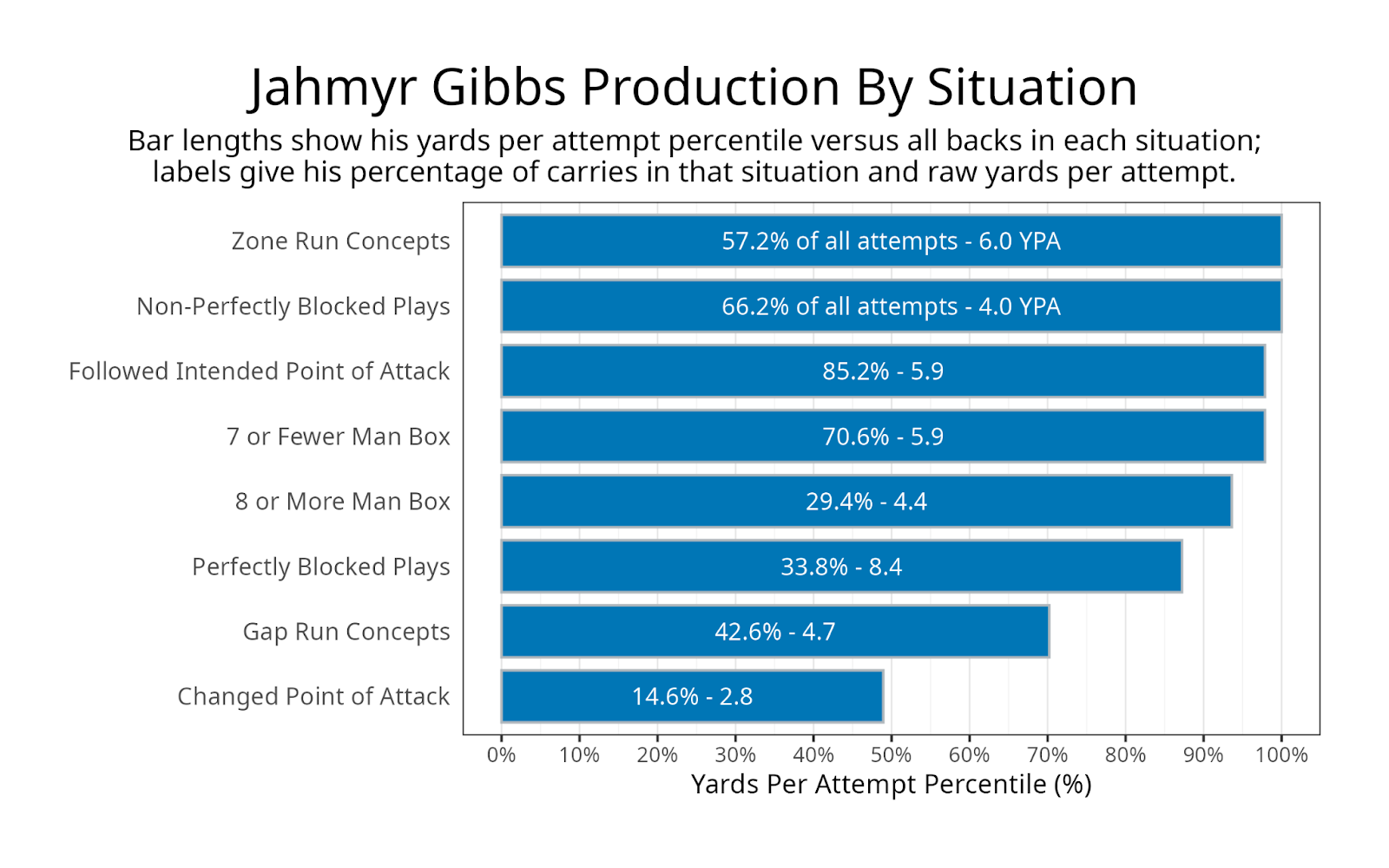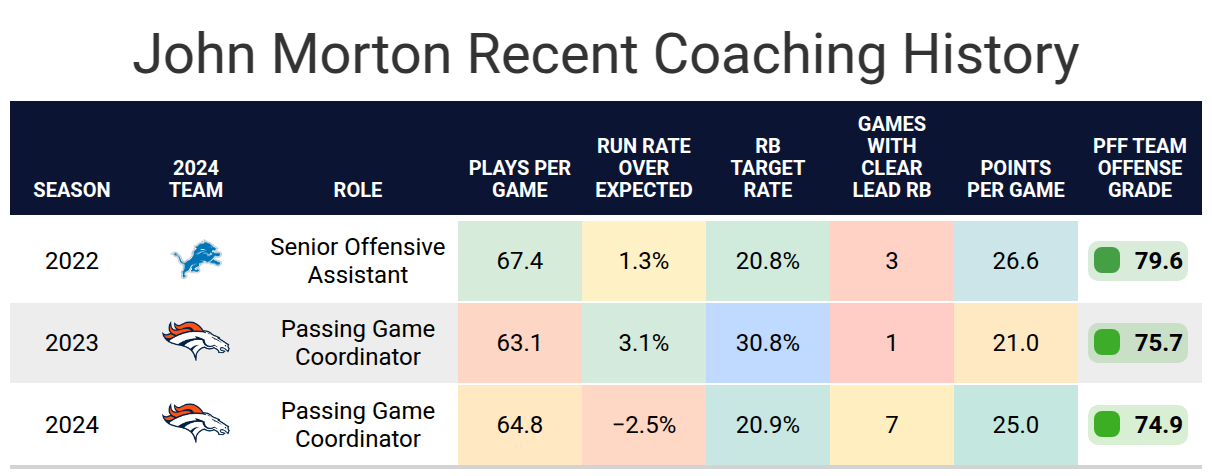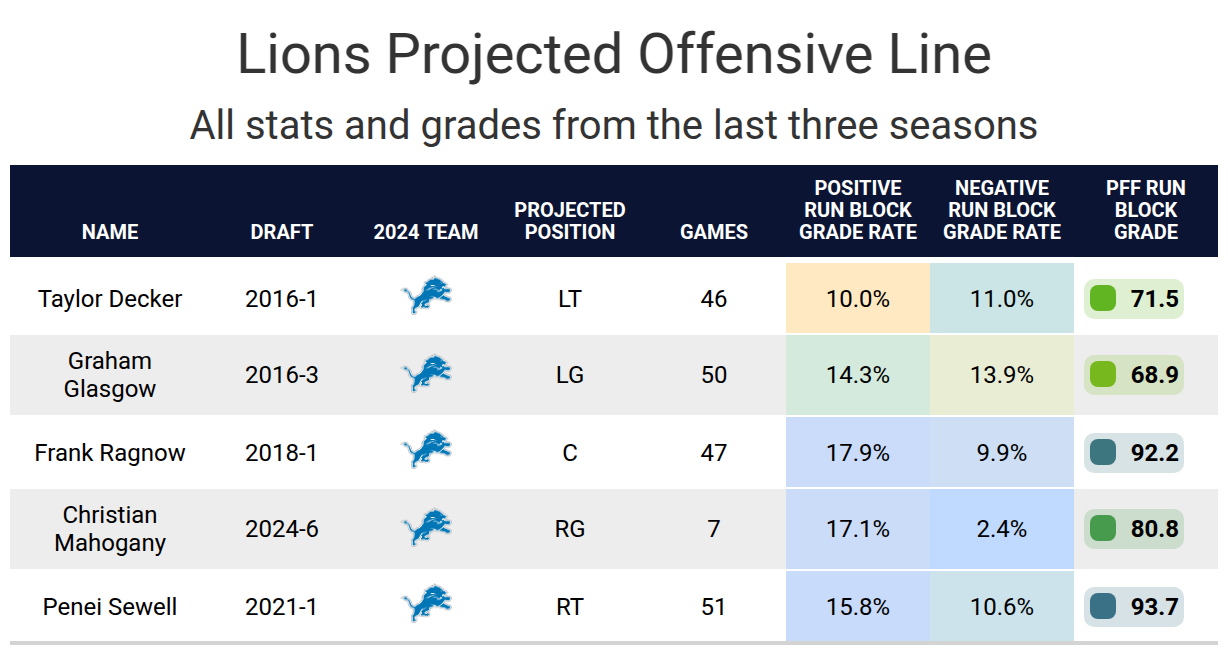Fantasy Football 2025: RB Jahmyr Gibbs player profile

2YTABDM Detroit Lions running back Jahmyr Gibbs rushes during an NFL football game, Thursday, Dec. 5, 2024, in Detroit. (AP Photo/Carlos Osorio)
By
- Jahmyr Gibbs finishes first in fantasy points: Gibbs finished second in fantasy points per game, but finished first overall because Saquon Barkley sat out the last week of the season.
- The potential for more opportunities: Gibbs has been held back by a timeshare with David Montgomery. A change in the offensive coaching staff could lead to more opportunities for Gibbs.
- Subscribe to PFF+: Get access to player grades, PFF Premium Stats, fantasy football rankings, all of the PFF fantasy draft research tools and more!
Estimated Reading Time: 5 minutes

PFF’s Fantasy Football Player Profile series delivers the most in-depth fantasy football analysis available for the 2025 season.
Using PFF’s exclusive data, we evaluate player performance, competition for touches and how teammates and coaching staffs will impact each player’s fantasy football outlook.
Last updated: 7:15 a.m. Tuesday, May 6
Click here for more draft tools:
Player performance
Gibbs was the 12th overall pick of the 2023 NFL Draft and is one of just three running backs selected with a top-20 pick in the last seven drafts. While most first-round picks quickly become feature backs, that hasn’t been the case for Gibbs. He played 57% of Detroit’s offensive snaps as a rookie. He surpassed 60% in six games, but three of them were when David Montgomery was inactive due to injury.
It was much the same in 2024, as David Montgomery played 41.4% of the snaps, while Gibbs played 55.7%. Montgomery often played in the first and third quarters and more on early downs, while Gibbs played more in the second and fourth quarters and later downs.
Gibbs’ fantasy value was still among the best running backs in the league thanks to his excellent play. He averaged 5.5 yards per attempt and 0.06 touchdowns per attempt over the last two seasons, which both rank second-best among running backs. This has led to 0.9 fantasy points per attempt, which is the best for running backs.
Through 15 games in 2024, he was fourth in fantasy points per game, and then Montgomery suffered a season-ending injury. This elevated Gibbs to a starter for the last three games of the regular season, as well as their postseason game. He played a little more but most notably saw an increase in touches per game. He averaged 24.2 touches per game without Montgomery compared to 16 touches with him. He also scored more touchdowns, leading to a ridiculous 33.3 fantasy points per game.



Projected role
The Lions didn’t make any changes to their backfield this offseason, which means that Montgomery will remain his primary competition. Gibbs’ snap rate by situation was remarkably consistent from 2023 to 2024, but the main difference was a significant increase in how much he touched the ball when he was on the field.
It’s worth noting that Montgomery had a slight decrease in run grade in 2024 compared to 2023. He will also be 28 years old at the start of the season, past the age at which running backs peak, while Gibbs is in the peak age range for a running back. Montgomery is still a good running back and would be worthy of starting on several teams, but Gibbs has simply played better. Just from age and quality of play alone, there is a chance the backfield could shift a little more in Gibbs’ favor in 2025.


Impact of teammates
Former Lions offensive coordinator Ben Johnson received the head coach job at the Chicago Bears. Scottie Montgomery had been working with the running backs, but now he’s working with the wide receivers. John Morton is the Lions’ new offensive coordinator, and he hasn’t worked with Morton before. Tashard Choice was added as the running back coach after a seven-year NFL career and working as a running back coach in college, most recently at Texas.
In recent seasons, Morton has been part of teams using a committee in the backfield, but he also has experience with feature backs, most notably Josh Jacobs. However, in his one season as an NFL offensive coordinator with the New York Jets in 2017, he had a three-back committee with Bilal Powell, Matt Forte and Elijah McGuire. Morton has stressed the importance of explosive plays, which is something Gibbs is exceptional at. We should expect how snaps and touches are distributed to change under Morton’s offense. Most of the potential changes should be positive instead of negative for Gibbs.
Gibbs benefits from having an excellent offensive line in front of him. Penei Sewell is the top run-blocking right tackle, and Frank Ragnow is the second-best run-blocking center in the league. Left tackle Taylor Decker has nearly a decade of history of great pass blocking but has been consistently good as a run blocker. The concern is at guard, where Graham Glasgow had a down year and will be 33 years old by the start of the season. Kevin Zeitler left in free agency. Christian Mahogany looked excellent on a small sample of 63 run blocks as a rookie, including a 91.9 run-blocking grade against the Washington Commanders in the playoffs as a starter. How he performs in his second year will likely determine if the Lions have the best offensive line in the league or just a top-five one. Regardless, this line is a big reason why Gibbs has been able to be so successful on fewer opportunities than other backs.


Bottom line
Gibbs finished first in fantasy points and second in points per game. Gibbs should finish among the top three in fantasy points per game thanks to his talent and offensive line. His ability to finish first in points per game will partially depend on whether his new offensive coordinator will give him a bigger role this season.

Footnotes
- Statistics in tables and charts were chosen based on their ability to predict future fantasy performance on a per-game or per-opportunity basis or to describe the player relative to others at the same position.
- “Opportunities” are defined as passing dropbacks, rushing attempts and routes run as a receiver.
- Numbers are provided either by season or based on the past three years. For rookies, only college statistics are included. For non-rookies, only NFL statistics are considered, regardless of whether they played in college within the previous three years.
- As college competition is easier than NFL competition, most rookies are likely to see a decline from their historical numbers.
- Only FBS data is considered for college players and comparisons.
- Kneel-downs are removed from rushing data to provide cleaner quarterback rushing rate statistics.
- The table colors in this article range from blue (indicating good/high) to red (indicating bad/low).
- All percentiles and color codings compare the given player to others with a high sample of opportunities. Generally, the cutoff is one-third of the possible opportunities in the sample. If a player does not meet the threshold, they are still included in the comparison, though their results may appear better or worse than expected due to the smaller, less predictive sample size.
- Information on utilization classifications and their importance can be found here for running backs, wide receivers and tight ends.




